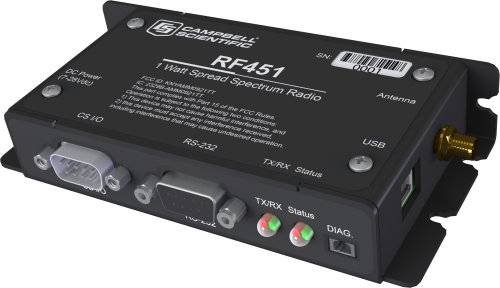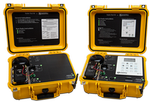
Try Before You Buy

If you are unsure if spread-spectrum communications is right for you, you can try before you buy. Campbell Scientific offers a 900 MHz spread-spectrum demonstration kit that allows you to easily test communications from one point to another using the RF407 and RF451 radios. Testing with RF451 radios will be valid for an RF452 network.
Product Line
| Frequency | Country Used In | Transmission Distance | |
|---|---|---|---|
RF452
|
902 to 928 MHz | US, Canada, New Zealand, Australia |
|
RF407
|
902 to 928 MHz | US, Canada |
|
Other Products
| Frequency | Country Used In | Transmission Distance | |
|---|---|---|---|
RF412
|
915 to 928 MHz | Australia, New Zealand |
|
RF422
|
863 to 870 MHz | EMEA (Europe, Middle East, and Africa) |
|
RF401A
|
910 to 918 MHz | US, Canada |
|
RF411A
|
920 to 928 MHz | Australia, New Zealand |
|
RF416
|
2.450 to 2.482 GHz | Any country where 2.4 GHz Wi-Fi communications are allowed | 0.4 km (0.25 mi) with omnidirectional antenna (outdoors); up to 0.8 km (0.5 mi) with higher-gain directional antennas at ideal conditions |
Retired Products
Documents
Brochures
Frequently Asked Questions
Number of FAQs related to Spread-Spectrum Radios: 5
Expand AllCollapse All
-
No. A spread-spectrum radio, like all FCC Part 15 devices, is not allowed to cause harmful interferences to licensed radio communications and must accept any interference that it receives.
-
Spread-spectrum radios work by frequency hopping and transmitting at discrete frequencies over part of the unlicensed band, rather than by transmitting over a very wide part of the spectrum as some other devices do.
-
Yes. Two spread-spectrum radios can be used to connect two computers.
-
No. Removing the interference will remove the radio signal. The radio, like all FCC Part 15 devices, is not allowed to cause harmful interferences to licensed radio communications and must accept any interference that it receives.
Privacy Policy Update
We've updated our privacy policy. Learn More
Cookie Consent
Update your cookie preferences. Update Cookie Preferences









